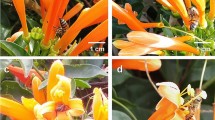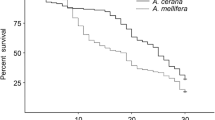Summary
Colony foraging activity of four Melipona species (Apidae: Meliponinae, tribe Meliponini) was studied during the dry season, when many plants flower in central Panama. The efficiency of sucrose solution uptake by Melipona was compared to that of domesticated European Apis mellifera. Dynamics of nectar foraging were also recorded for 3 of the Melipona visiting the forest shrub, Hybanthus prunifolius (Violaceae).
-
1.
Sugar concentration in nectar brought to nests averaged from 21 to 60% sugar for 15 colonies of M. fasciata, M. compressipes triplaridis, M. fuliginosa and M. marginata micheneri. Concentrations ranged from 19 to 72%, and all species collected nectars ranging at least between 24 and 63% sugar. However, M. compressipes and M. marginata preferred higher concentrations and foraged less on dilute nectars. Peak colony nectar harvest occured in late morning or early afternoon; peak pollen harvest was in early morning.
-
2.
Imbibing rates of bees given 20, 30, 45, 60 or 70% sucrose solutions were highest at ≦45% sucrose, but caloric intake was most rapid at 60% sucrose for all species. All but M. marginata displayed greater net intake rates than domesticated European Apis mellifera. A foraging choice model incorporating caloric reward and imbibing rates of bees suggests M. compressipes and M. marginata should specialize on richer nectars. Rate of caloric intake per forager weight was higher for all Melipona (0.03–0.13g) than for A. mellifera (0.10 g).
-
3.
The nectar of Hybanthus prunifolius (Violaceae), a shrub pollinated exclusively by Melipona, progressed from 35 to 60% sugar during the day. Bees foraged most when nectar was below 60% concentration, a pattern best explained as the result of intercolony competition and greater availability of lower quality nectar.
-
4.
Sugar concentration in nectar harvested by colonies rose from lower to higher values through the day for Melipona. The increasing caloric reward of nectar is adaptive in exploiting foraging preferences of such bees. As standing nectar crop is depleted by competing bees, a gradual shift to more rewarding nectar should promote increased bee foraging range, more flower visits during a foraging trip, floral constancy, and genetic outcrossing.
-
5.
The nectar load capacity of A. mellifera is greater than that of Melipona. Other factors being equal, Africanized A. mellifera, now a permanent resident of neotropical forests, should visit more flowers during a foraging trip. Additional species differences in foraging behavior are analyzed.
Similar content being viewed by others
References
Augspurger CK (1980) Mass-flowering of a tropical shrub (Hybanthus prunifolius): Influence on pollinator attraction and movement. Evolution 34:475–488
Baker HG, Bawa KS, Frankie GW, Opler PA (1983) Reproductive biology of plants in tropical forests. In: Golley FB (ed) Tropical rain forest ecosystems, Elsevier Scientific, New York, pp 183–215
Baker HG, Hurd P (1968) Intrafloral ecology. Ann Rev Ent 13:385–414
Buchmann SL, Shipman CW (in prep.) Optimal nectar feeding rates in Apis mellifera (Hymenoptera: Apidae)
Corbet SA, Willmer PG (1981) The nectar of Justicia and Columnea: Composition and concentration in a humid tropical climate. Oecologia (Berlin) 51:412–418
Croat TC (1978) Flora of Barro Colorado Island. Stanford University Press Palo Alto
Ducke A (1925) Die stachellosen Bienen Brasiliens. Zool. Jahrb. 49 Abt für Syst 335–448
Foster R (1982) The seasonal rhythm of fruitfall on Barro Colorado Island. In: Leigh EG, Rand AS, Windsor DM (eds) The ecology of a tropical forest: Seasonal rhythms and long-term changes. Smithsonian Inst Press, Washington DC, pp 151–172
Frankie GW, Haber WA (1983) Why bees move among massflowering neotropical trees. In: Jones E, Little RJ (eds) Handbook of experimental pollination ecology, Van Nostrand, New York, pp 360–372
Free JB (1956) A study of the stimuli which release the food begging and offering responses of worker honeybees. Br J Anim Behav 4:94–101
Frisch K von (1967) The dance language and orientation of bees. Belknap Press of Harvard Univ Press, Cambridge, Mass
Heinrich B (1975) Energetics of pollination. Ann Rev Syst Ecol 6:139–170
Heinrich B, Raven PH (1972) Energetics and pollination ecology. Science 176:597–602
Hubbell SP (1979) Tree dispersion, abundance, and diversity in a tropical dry forest. Science 203:1299–1309
Hubbell SP, Johnson LK (1977) Competition and nest spacing in a tropical stingless bee community. Ecology 58:949–963
Hubbell SP, Johnson LK (1978) Comparative foraging behavior of six stingless bee species exploiting a standardized resource. Ecology 59:1123–1136
Inouye DW (1978) Resource partitioning in bumblebees: Experimental studies of foraging behavior. Ecology 59:672–678
Johnson LK (1981) Effect of flower clumping on defense of artificial flowers by aggressive stingless bees. Biotropica 13:151–157
Johnson LK, Hubbell SP (1974) Aggression and competition among stingless bees: Field studies. Ecology 55:120–127
Johnson LK, Hubbell SP (1975) Contrasting foraging strategies and coexistence of two bee species on a single resource. Ecology 56:1398–1406
Marden JH, Waddington KD (1981) Floral choices by honey bees in relation to the relative distance to flowers. Physiol Entomol 6:431–435
Michener CD (1974) Social behavior of the bees. Belknap Press of Harvard University Press, Cambridge, Mass
Michener CD (1975) The Brazilian bee problem. Ann Rev Entomol 20:399–416
Michener CD (1979) Biogeography of the bees. Ann Missouri Bot Gard 66:277–347
Nuñez JA (1982) Honey bee foraging strategies at a food source in relation to its distance from the hive and the rate of sugar flow. J Apic Res 21:139–150
Pyke GH (1978) Optimal foraging in bumblebees: Patterns of movement between inflorescences. Theor Popul Biol 13:72–98
Pyke GH (1982) Local geographic distributions of bumblebees near Crested Butte, Colorado: Competition and community structure. Ecology 63:555–573
Pyke GH, Blazer L (1982) The effects of the introduced honey bee Apis mellifera on Australian native bees. Report to the New South Wales National Parks and Wildlife Service
Rand AS, Rand WM (1982) Variation in rainfall on Barro Colorado Island. In: Leigh EG, Rand AS, Windsor DM (eds) The ecology of a tropical forest: Seasonal rhythms and long-term changes. Smithsonian Inst Press, Washington, DC, pp 47–60
Roubik DW (1978) Competitive interactions between Africanized honey bees and neotropical pollinators. Science 201:1030–1032
Roubik DW (1979a) Competition studies of colonizing Africanized honey bees and native pollinators in South America. Dissertation, University of Kansas, Lawrence, Kansas USA
Roubik DW (1979b) Nest and colony characteristics of stingless bees from French Guiana. J Kans Ent Soc 52:443–470
Roubik DW (1980) Foraging behavior of competing Africanized honey bees and stingless bees. Ecology 61:836–845
Roubik DW (1981) Comparative foraging behavior of Apis mellifera and Trigona corvina (Hymenoptera: Apidae) on Baltimora recta (Compositae). Revista de Biologia Tropical 29:177–184
Roubik DW (1982a) Africanized honey bees confirmed in Panama. Amer Bee J 122:322
Roubik DW (1982b) The ecological impact of nectar-robbing bees and pollinating hummingbirds on a tropical shrub. Ecology 63:354–360
Roubik DW (1982c) Obligate necrophagy in a social bee. Science 217:1059–1060
Roubik DW (1982d) Seasonality in colony food storage, brood production and adult survivorship: Studies of Melipona in tropical forest (Hymenoptera: Apidae). J Kan Entomol Soc 55:789–800
Roubik DW (1982e) Ecological impact of Africanized honey bees on native neotropical pollinators. In: Jaisson P (ed) Social insects in the tropics, vol 1. Univ Paris-Nord, pp 233–247
Roubik DW (1983a) Nest and colony characteristics of stingless bees from Panama. J Kans Ent Soc 56:327–355
Roubik DW (1983b) Experimental community studies: Time-series tests of competition between African and Neotropical bees. Ecology 64:1100–1110
Roubik DW, Aluja M (1983) Flight ranges of foraging Melipona and Trigona in a tropical forest. J Kans Ent Soc 56:217–222
Schoener TW (1983) Field experiments on interspecific competition. Amer Natur 122:240–285
Schwarz HF (1932) The genus Melipona. Bull Amer Mus Nat Hist 63:231–480
Schwarz HF (1934) The social bees of Barro Colorado Island, Canal Zone. Amer Mus Novit No 731, 1–23
Thomson JD, Plowright RC (1980) Pollen carryover, nectar rewards, and pollinator behavior with special reference to Diervilla lonicera. Oecologia (Berlin) 46:68–74
Thomson JD, Maddison WP, Plowright RC (1982) Behavior of bumble bee pollinators of Aralia hispida Vent (Araliaceae). Oecologia (Berlin) 54:326–336
Visscher PD, Seeley TD (1982) Foraging strategy of honey bee colonies in a deciduous forest. Ecology 63:1790–1801
Waddington KD (1980) Flight patterns of foraging bees relative to density of artificial flowers and distribution of nectar. Oecologia (Berlin) 44:199–204
Wells PH, Giacchino J (1968) Relationship between the volume and the sugar concentration of loads carried by honey bees. J Apic Res 20:77–82
Whitham TG (1977) Coevolution of foraging in Bombus and nectar dispensing in Chilopsis: A last dreg theory. Science 197:593–596
Wiens JA (1977) On competition and variable environments. Amer Sci 65:590–597
Wille A (1982) Biology of the stingless bees. Ann Rev Entomol 28:41–64
Zimmerman M (1980) Reproduction in Polemonium: Competition for pollinators. Ecology 61:497–501
Author information
Authors and Affiliations
Rights and permissions
About this article
Cite this article
Roubik, D.W., Buchmann, S.L. Nectar selection by Melipona and Apis mellifera (Hymenoptera: Apidae) and the ecology of nectar intake by bee colonies in a tropical forest. Oecologia 61, 1–10 (1984). https://doi.org/10.1007/BF00379082
Received:
Issue Date:
DOI: https://doi.org/10.1007/BF00379082




